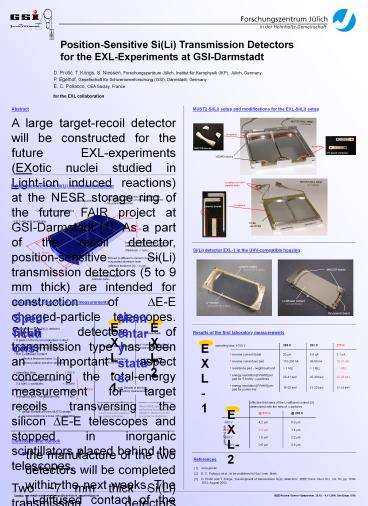PowerPoint-Pr - PowerPoint PPT Presentation
Title:
PowerPoint-Pr
Description:
Position-Sensitive Si(Li) Transmission Detectors for the EXL-Experiments at GSI-Darmstadt D. Proti , T. Krings, S. Niessen, Forschungszentrum J lich, Institut f r ... – PowerPoint PPT presentation
Number of Views:50
Avg rating:3.0/5.0
Title: PowerPoint-Pr
1
Position-Sensitive Si(Li) Transmission Detectors
for the EXL-Experiments at GSI-Darmstadt
D. Protic, T. Krings, S. Niessen,
Forschungszentrum Jülich, Institut für Kernphysik
(IKP), Jülich, Germany P. Egelhof, Gesellschaft
für Schwerionenforschung (GSI), Darmstadt,
Germany E. C. Pollacco, CEA Saclay, France
for the EXL collaboration
Abstract
MUST2-Si(Li) setup and modifications for the
EXL-Si(Li) setup
A large target-recoil detector will be
constructed for the future EXL-experiments
(EXotic nuclei studied in Light-ion induced
reactions) at the NESR storage ring of the future
FAIR project at GSI-Darmstadt 1. As a part of
the recoil detector, position-sensitive Si(Li)
transmission detectors (5 to 9 mm thick) are
intended for construction of DE-E
charged-particle telescopes. Si(Li) detectors of
transmission type has been an important aspect
concerning the total-energy measurement for
target recoils transversing the silicon DE-E
telescopes and stopped in inorganic scintillators
placed behind the telescopes. Two 7 mm thick
Si(Li) transmission detectors equipped with 8
pads on the implanted p-contact have being
prepared for the test measurements at ESR
(GSI-Darmstadt). To relieve the efforts for the
first experiments a telescope configuration and
position-sensitive structure very similar to that
of the MUST2 experiment (SACLAY, ORSAY and GANIL)
will be applied 2, but with UHV-capable
components. Results of the test measurements in
the laboratory are presented.
MUST2-Si(Li) setup
(n-contact)
to replace
to replace
MACOR-blocks
HV-board (ceramic)
VESPEL-blocks
MUST2-Si(Li) setup
to replace by UHV-capable parts
Schematic view of the Si(Li) transmission detector
(p-contact)
8 position elements (pads) are separated by 60
mm wide and 15 mm deep plasma etched
(SF6-plasma) grooves
Al-bonded wires
to replace
ceramic boards
200 mm wide connecting strips
Ø 102 mm
Ø 92 mm
3 to 5 mm wide guard-ring
PCBs out of FR4
6.5 mm
boron-implanted p-contact covered with
evaporated aluminum layer (thickness lt 1mm)
Si(Li) detector EXL-1 in the UHV-compatible
housing
48 mm
thinned Li-diffused n-contact covered with
evaporated aluminum layer (effective thickness
3 lt 5 mm)
54 mm
ceramic board
MACOR blocks
(to contact the 8 pads)
Li-compensated region (intrinsic zone)
Li-diffused contact
Si(Li) detector prototype for test measurements
p-contact
(not yet thinned)
(structured with 8 pads)
Specifications
Momentary status
HV ceramic board
EXL-1
EXL-2
- transmission type Si(Li) detector
Results of the first laboratory measurements
- 6.5 mm thick
6.5 mm thick
6.4 mm thick
- 8 pads on the boron-implanted contact
- the same structure as for the Si(Li) detectors
for the MUST2-setup
p-contact is still without position-sentive
structure
298 K
283 K
275 K
operating bias 700 V
p-contact is structured
- thin Li-diffused contact
- reverse current (total)
20 mA
6.0 mA
3.1 mA
- effective thickness below 5 mm
- without position-sensitive structure
Li-diffused contact has to be thinned
3 mm thick Li-diffused contact
- reverse current per pad
110-200 nA
30-60 nA
15-31 nA
- resistance pad - neighbourhood
gt 1 MW
gt 1 MW
gt 1 MW
- operating bias
? 700 V
- energy resolution FWHM per pad for 5.8 MeV
a-particles
26-41 keV
25-30 keV
23-25 keV
- energy resolution FWHM for 5.8 MeV a-particles
lt 50 keV
- energy resolution FWHM per pad for pulser line
15-29 keV
13-20 keV
11-13 keV
see Results of the first laboratory measurements
T 273 K
- reverse current / pad
lt 250 nA
- resistance pad - neighbourhood
gt 1 MW
effective thickness of the Li-diffused contact
3 determined with the help of a-particles
- housing / frame
the photolithography for performing the
position-sensitive structure on the p-contact is
started up
test measurements (energy resolution, reverse
current, inter pad resistance) are being performed
- design is identical to the MUST2-design
- all components have to be UHV-compatible
_at_ 273 K
_at_ 298 K
600 V
4.2 mm
5.0 mm
700 V
2.3 mm
3.4 mm
operating bias
800 V
1.5 mm
2.2 mm
Conclusion and outlook
1000 V
0.6 mm
0.8 mm
- the manufacture of the two detectors will be
completed within the next weeks. The Li-diffused
contact of the Si(Li) detector EXL-1 will be
thinned and the p-contact of the Si(Li) detector
EXL-2 will receive the position-sensitive
structure. - UHV-capable components of the detector holder
have been already finished - test measurements in UHV environment will be
performed inside the ESR-ring at GSI-Darmstadt
References
1 www.gsi.de 2 E. C. Pollacco et al., to be
published in Nucl. Instr. Meth. 3 D. Protic and
T. Krings, Development of transmission Si(Li)
detectors, IEEE Trans. Nucl. Sci., vol. 50, pp.
1008-1012, August 2003
IEEE Nuclear Science Symposium, 29.10.
4.11.2006, San Diego, USA
Contact d.protic_at_fz-juelich.de,
t.krings_at_fz-juelich.de, p.egelhof_at_gsi.de






























